Holidays of grief and gratitude
It is a truism of being human: loss and grief focus, illuminate and amplify joy and gratitude. Sides of the same coin. Our gratefulness can grow as our experience with grief expands–it’s built into the arc of a life. Who escapes this earth without pain? For the rare person who does, the trade off is to miss some part of understanding the power of gratitude.
This is one of those years when the lunar calendar brings together the holidays of Easter and Passover. (Easter is the only major Christian holiday based on the lunar calendar; while all Jewish holidays are calculated on the lunar year.) Both celebrate the seemingly contradictory experiences of grief and gratitude.
As an observer of Christian holidays and traditions, it has always seemed to me that Easter is the most profound of those holidays. A beloved deity is experienced here on earth, then lost, and ultimately restored, albeit under new conditions, forever. Rather than knowing the deity as a fellow man, the deity is now revealed and experienced as the son of G_d. Those who believe in the Christian story of Easter feel the pain of the crucifixion, but above all else a life-changing sense of gratitude for having Jesus Christ to worship and know spiritually.
On a more mundane or mortal level, this narrative path is not unlike the emotions we experience with the loss of a deeply loved family member or friend. We begin with pleasure in knowing and living with the person, we feel pain if they die, and then, one hopes, we come to a place of gratitude: for having had them in our lives, for having the lessons and memories we take from our time with them.
I do not mean to sound gratuitous here. Pain is pain; joy is joy. But gratitude binds and amplifies both emotions.

Seder plate. Not one but two slots for bitter herbs. Remember that pain. Photo: Jodi Bart
Passover, too, recognizes grief and celebrates gratitude. This is a holiday I know more intimately than Easter. Aside from the autumn celebration of the New Year and the solemnity of Yom Kippur, Passover is the most important holiday in the Jewish tradition I grew up in. Passover tells the story of the pain of slavery and homelessness finally ending with a new home and freedom. But, the symbolic elements of the seder table and service make a point of keeping the pain–salt water to represent tears, bitter herbs the taste of slavery–in close proximity to the gratitude for freedom.
From the grief and gratitude comes the heart of both Easter and Passover: hope. For the Christian, hope for salvation and eternal life in the G_d found, lost and found again. For the Jew, hope inspired by the possibilities of freedom and rebirth in a new land. These holidays are set in the right time of year: the season of hope, of new life.
Regardless of your religious or spiritual beliefs, spring brings us out of our homes and back into life to smell the dirt and hear the birds and see the first tender green push through earth. The pain of our lives is still there, but there’s promise in the air and for that I am grateful.










Ellen,
Your piece here took me back to 12 years of religious instruction in Catholic schools.
In Catholic teaching, the Original Sin committed by Adam and Eve is called “The Happy Fault.”
Why? Because without Adam and Eve sinning, there would not have been any need for Jesus to redeem humans.
Lovely and thoughtful piece!